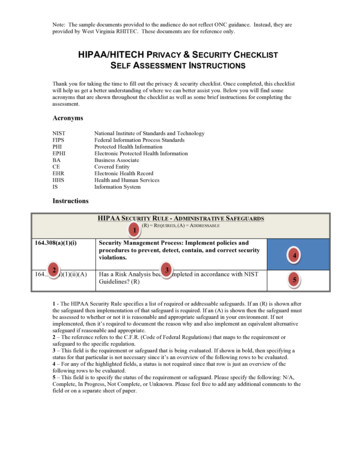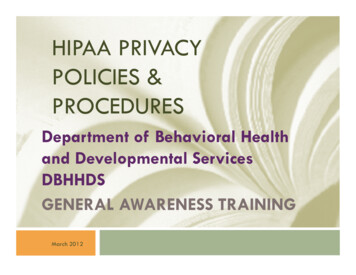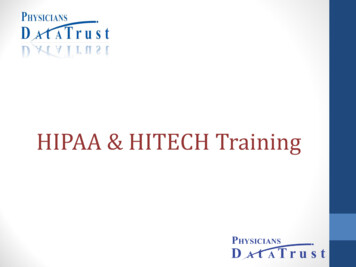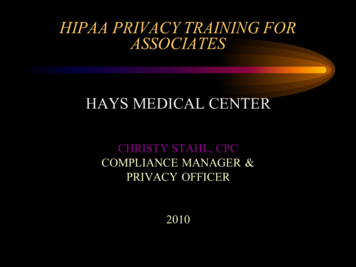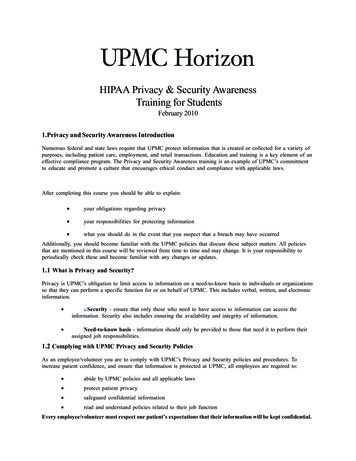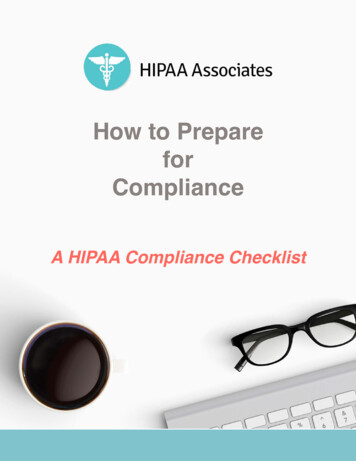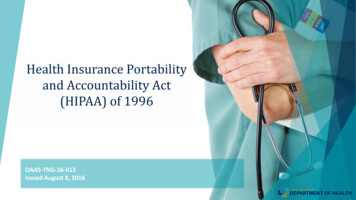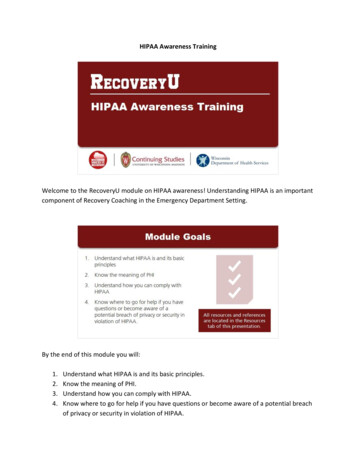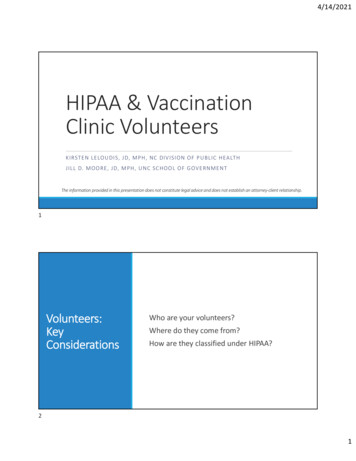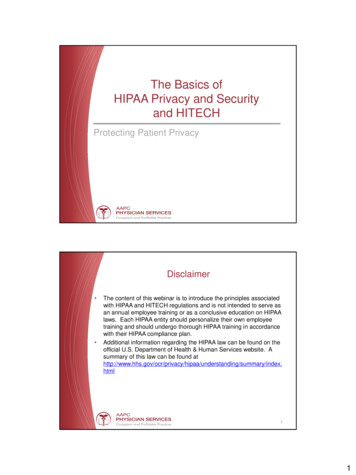
Transcription
The Basics ofHIPAA Privacy and Securityand HITECHProtecting Patient PrivacyDisclaimer The content of this webinar is to introduce the principles associatedwith HIPAA and HITECH regulations and is not intended to serve asan annual employee training or as a conclusive education on HIPAAlaws. Each HIPAA entity should personalize their own employeetraining and should undergo thorough HIPAA training in accordancewith their HIPAA compliance plan.Additional information regarding the HIPAA law can be found on theofficial U.S. Department of Health & Human Services website. Asummary of this law can be found ng/summary/index.html21
Objectives Become familiar with HIPAA regulations and therequirements for compliance Understand HITECH regulations and how theyapply to compliance in your practice Awareness of expectations for compliance andconsequences of non compliance Know how to properly respond to concerns3What is HIPAA? Health Insurance Portability and Accountability Actof 1996 HIPAA Privacy – Protection for the privacy ofProtected Health Information (PHI) HIPAA Security – Protection for the security ofelectronic Protected Health Information (e-PHI)42
What is the difference betweenPrivacy and Security? The Privacy Rule sets the standards for how tomaintain the privacy of personal information in allof its forms. It’s focus is on overall confidentiality. The Security Rule defines the standards forsafeguards of personal information specificallyrelated to electronic PHI (e-PHI).– Successfully privacy rule will depend on a goodimplementation of the security rule.5Who Does This Law Apply To?Individuals, organizations, and agencies that meet thedefinition of a covered entity under HIPAA must comply withthe Rules' requirements to protect the privacy and securityof health information and must provide individuals withcertain rights with respect to their health information. If anentity is not a covered entity, it does not have to comply withthe Privacy Rule or the Security Rule.63
Covered Entities A covered entity is a– healthcare provider,– a health plan,– healthcare clearing house .who transmits any health information in electronic form7Covered EntitiesHealth Care Provider Doctors Clinics Psychologists Dentists Chiropractors Nursing Homes PharmaciesA Health Plan Health insurancecompanies HMOs Company health plans Government programsthat pay for health care,such as Medicare,Medicaid, and the if they transmit anymilitary and veteransinformation in an electronic health care programsClearinghouseIncludes entities thatprocess nonstandardhealth information theyreceive from anotherentity into a standard(i.e., standard electronicformat or data content),or vice versa.form in connection with atransaction for which HHShas adopted a standard.http://www.cms.gov/HIPAAGenInfo/06 AreYouaCoveredEntity.asp84
Business Associates A “business associate” is a person or entity that performs certainfunctions or activities that involve the use or disclosure of protectedhealth information on behalf of, or provides services to, a coveredentity but is not part of that entity.A person or business is NOT a “business associate” if theirfunctions or services do not involve the use or disclosure ofprotected health information, and where any access to protectedhealth information by such persons would be incidental, if at all. (i.e.janitor, building maintenance, taxaccountant, etc)9Privacy RuleProtected Health Information is: Individually identifiable health information held or transmittedby a covered entity or its business associate, in any form ormedia, whether electronic, paper, or oral.– The individual’s past, present or future physical or mental health– Health care services provided to the individual– Payment for health care services Includes all demographic information that identifies or canbe used to identify the individual.105
Examples of PHI Name Address (including street, city, county, zip code andequivalent geocodes) Name of employer Any date (birth, admit date, discharge date) Telephone and Fax numbers Electronic (email) addresses Social Security Number Medical Records11Permitted Disclosure of PHI Individual who is the subject of informationTPO – Treatment, Payment, Operations: Treatment- coordination of care between one or more healthcare providers Payment- activities required to bill and collect for health careservices provided to the patient. Operations- includes business management andadministrative activities, quality improvement, billing,collections, audits, and training126
Principle of Minimum Necessary A covered entity must make reasonable efforts to use,disclose, and request only the minimum amount of protectedhealth information needed to accomplish the intendedpurpose of the use, disclosure, or request. (i.e. If the wholemedical record is not needed to fulfill the request, then onlysend the parts that are needed)Minimum Necessary is NOT required for the following: Requests by a health care provider for treatment purposes.Disclosures to the individual who is the subject of the information.Disclosures made pursuant to an individual’s authorization.Disclosures to the Department of Health and Human Services(HHS)Uses or disclosures that are required by other law13Notice of Privacy Practices (NPP) HIPAA requires each entity to1. Provide each patient a copy of their NPP that describes how a covered entity may use or disclose (PHI), what the patient’s rights are and what the covered entity’s obligations are with respect to thatinformation.2. Request acknowledgement of receipt from the patient Acknowledgement can be done in a variety of formats The patient signs a statement that they have received orbeen given access to the entities NPP.3. Post the NPP at each site in a clear and prominent place andon the website if one exists.147
Is the Patient Required To Sign The NPP? The law does not require patients to sign the“acknowledgement of receipt of the notice” in order to receiveservices. If the patient refuses to sign the acknowledgement, theprovider must note that it was offered and refused. In an emergency situation, delivery of the NPP andacknowledgement is not required prior to delivering services butshould be done after.- Signing the acknowledgement does not mean that the patientagrees to any special uses or disclosures of his or her healthrecords.15Other Uses and Disclosures of PHI Written authorization for any use or disclosure of protectedhealth information that is not for TPO or otherwise permitted.(life insurance, employers, research, marketing, etc) The authorization should––––––Describe the PHI to be used or releasedIdentify who may use or release the PHIIdentify who may receive the PHIDescribe the purposes of the use or disclosureIdentify when the authorization expiresBe signed by the patient or someone making health caredecisions (personal representative) for the patient168
Patients Rights The right to request alternative forms of communications(mail to P.O. Box instead of street address, no message onanswering machine, etc.) The right to access and copy patient’s PHI The right to an accounting of the disclosures of PHI The right to request restriction of PHIuses & disclosures The right to request amendmentsto information17Basics for Protecting PHI Look at a patient’s PHI only if you need it to perform your jobUse a patient’s PHI only to the extent that is required to performyour jobGive a patient’s PHI to others only when it’s necessary for them toperform their jobsTalk to others about a patient’s PHI only if it is necessary to performyour job, and do it discreetlyReasonable standards for differentgroups189
Privacy Administrative Requirements Develop and implement written privacy policies andprocedures Designate a privacy official Train all workforce members on privacy policies andprocedures Have and apply appropriate discipline against employeeswho violate privacy policies and procedures Safeguard PHI Maintain all HIPAA documents for a period of 6 years19Privacy Rule Summary Using PHI for TPO and other authorizations Securing PHI so as not to be readily available to those whodo not require access Notifying patient about his or her privacy rights and how theirinformation can be used Adopting and implementing privacy policies and proceduresand designating a privacy officer to oversee Training employees so that they understand these privacyprocedures2010
HIPAA Security Rule The Security Rule protects a subset of information covered by thePrivacy Rule, which is all individually identifiable health informationa covered entity creates, receives, maintains or transmits inelectronic form. The Security Rule calls this information “electronicprotected health information” (e-PHI). The Security Rule does notapply to PHI transmitted orally or in writing. The Security Rule requires covered entities to maintain reasonableand appropriate administrative, technical, and physical safeguardsfor protecting e-PHI21HIPAA Security Safeguards Administrative Safeguards– Security management process– Information access management– Workforce training, management and evaluationPhysical Safeguards– Facility access and control– Workstation and device securityTechnical Safeguards– Access controls– Audit controls– Integrity controls– Transmission security2211
Basic Security Guidelines Secure logins and Passwords – each person who accesses PHIshould have their own unique user ID and password. Passwordsshould be kept confidential and not shared with anyone else.Passwords should be changed periodicallyEmail encryption – all emails with PHI should be secured withencryption and include a confidentiality statement within the email.Workstation security –lock up systems when not being used, logoff when leaving a computer, encrypt information stored on thecomputer, and use screen savers when stepping away.Disaster Controls - protect systems against hazards or naturaldisasters, locate above ground, surge protectorsMalware – protect against viruses, spyware, and worms that couldcompromise security, avoid suspicious email2390/10 RuleRemember10% of security safeguards are technical90% of security safeguards rely on the computeruser to adhere to good computing practices2412
HITECH Health Information Technology for Economic and ClinicalHealth Act HITECH is a part of the American Recovery and Reinvestment Actof 2009 (ARRA)It is a federal law that affects the healthcare industry– Allocated 20 billion to health information technology projects– Expanded the reach of HIPAA by extending certain obligationsto business associates– Imposed a nationwide security breach notification law– Added teeth to enforcement 25What is a Breach? Only applies to unsecured PHI1. Use or disclosure of the patients PHI that is not permittedunder the privacy rule2. The use or disclosure compromises the security or privacyof the patient’s PHI– If there is not a risk of significant financial, reputational orother harm to the individual whose PHI was used ordisclosed it is not considered a HITECH breach but aviolation of the Privacy Rule2613
Breach Notification A major portion of the HITECH law that is currently in effect! The law requires covered entities and business associates tonotify the following in the event of a breach with 60 days– individuals,– the Secretary of Health and Human Services,– the media (if breach affected over 500 people) There are exceptions27Breach Notification Components of the notification must include;– A description of the breach,– a description of the types of information that were involved inthe breach,– the steps affected individuals should take to protect themselvesfrom potential harm,– a brief description of what the covered entity is doing toinvestigate the breach, mitigate the potential harm, and preventfuture breaches from occurring,– provide contact information for the covered entity.Additional information can be found on HHS website ive/breachnotificationrule/index.html2814
Examples of PHI Breaches An employee is curious about his or her favoriteprofessional football quarterback who is a patientat the practice or hospital and accesses thepatient’s medical record then shares with friends. An unencrypted thumb drive containing PHI is leftin a car and the car is stolen. PHI is faxed to the wrong number outside of thecovered entity. PHI has been changed or destroyed in anunauthorized manner.29Enforcement HHS will be conducting audits of Covered Entities and BusinessAssociates to ensure their compliance with the Privacy and SecurityRules (this is already happening)Covered entities and individuals may be subject to civil moneypenalties. Maximum raised from 25,000 to 1.5 Million per yearHITECH expanded ability to impose criminal penalties for violationsNo longer can parties avoid penalties by claiming that they did nothave actual or constructive knowledge of the violationRegulations will be issued permitting portions of financial recoveriesfor HIPAA violations to be paid by HHS directly to individualsharmed by the violation3015
FAQHHS website provides answers to many frequently asked questionsregarding HIPAA privacy and index.html31Test What You’ve Learned1) The Notice of Privacy Practices (NPP) must be:A.B.C.D.Offered to each patient at the first visit after April 14, 2003Posted on my website, if I have onePosted in the officeAll of the above3216
Test What You’ve Learned1) The Notice of Privacy Practices (NPP) must be:A.B.C.D.Offered to each patient at the first visit after April 14, 2003Posted on my website, if I have onePosted in the officeAll of the aboveAnswer: D The NPP must be offered to every patient, postedon the website and posted in a prominent place at each site.33Test What You’ve Learned (continued)2) When a patient requests access to his/her medical records:A. I always have to provide them a complete copyB. I can provide a summary if I think it is too difficult for the patient tointerpret or if information may be deemed harmfulC. I can charge a reasonable fee for copying and postageD. B and C3417
Test What You’ve Learned (continued)2) When a patient requests access to his/her medical records:A. I always have to provide them a complete copyB. I can provide a summary if I think it is too difficult for the patient tointerpret or if information may be deemed harmfulC. I can charge a reasonable fee for copying and postageD. B and CAnswer: D Information such as psychotherapy notes, informationcompiled for legal proceedings, and laboratory results to which theClinical Laboratory Improvement Act (CLIA) prohibits access may notbe granted to a patient. A reasonable cost based fee may be charged.35Test What You’ve Learned (continued)3) Protected health information (PHI) can ONLY be given out afterobtaining written authorization.A. TrueB. False3618
Test What You’ve Learned (continued)3) Protected health information (PHI) can ONLY be given out afterobtaining written authorization.A. TrueB. FalseAnswer: B False- PHI can be given out for Treatment, Payment,or Operations37Test What You’ve Learned (continued)4) If a patient wants to request a restriction on the disclosure of his/herprotected health information (PHI):A.B.C.D.The covered entity must agree to itIt must be in writingCan be retroactive to cover information already releasedThe patient can not restrict disclosure of his PHI3819
Test What You’ve Learned (continued)4) If a patient wants to request a restriction on the disclosure of his/herprotected health information (PHI):A.B.C.D.The covered entity must agree to itIt must be in writingCan be retroactive to cover information already releasedThe patient can not restrict disclosure of his PHIAnswer: B This request must be in writing, will apply to allfuture disclosures, and the entity must consider and comply withthe request unless superseded by other federal or state law.39Test What You’ve Learned (continued)5) I don't have to worry about the minimum necessary requirement for:A.B.C.D.Disclosures to or requests by a health care provider for treatmentUses or disclosures made pursuant to an authorizationUses or disclosures made to the individuals familyDisclosures made to the Secretary of Health and Human Services(HSS), pursuant to the stated rulesE. All of the aboveF. A, B, and D only4020
Test What You’ve Learned (continued)5) I don't have to worry about the minimum necessary requirement for:A.B.C.D.Disclosures to or requests by a health care provider for treatmentUses or disclosures made pursuant to an authorizationUses or disclosures made to the individuals familyDisclosures made to the Secretary of Health and Human Services(HSS), pursuant to the stated rulesE. All of the aboveF. A, B, and D onlyAnswer: FComplete record information may be released toanother health care provider for treatment, pursuant to anauthorization from the patient, or as required by HHS.41Test What You’ve Learned (continued)6) I don't need a business associate agreement for:A.B.C.D.My employeesMy cleaning serviceIndependent entity providing medical chart audits for my practiceContracted employees such as a physical therapist who perform asubstantial portion of their work at my practiceE. None of the aboveF. A, B, and D only4221
Test What You’ve Learned (continued)6) I don't need a business associate agreement for:A.B.C.D.My employeesMy cleaning serviceIndependent entity providing medical chart audits for my practiceContracted employees such as a physical therapist who perform asubstantial portion of their work at my practiceE. None of the aboveF. A, B, and D onlyAnswer: FBusiness Associate agreements are not required foremployees or other entities not involved in the use or disclosure ofprotected health information43Test What You’ve Learned (continued)7) A privacy officer should conduct the following steps:A. Identify the internal and external risks of disclosure of protectedhealth information (PHI)B. Create and implement a plan to reduce the risk of releasing PHI inthose areas identifiedC. Train all personnel on the practice's privacy and security of PHID. Monitor the implementation and enforce appropriately any breachesof policyE. All of the aboveF. A, B, and D only4422
Test What You’ve Learned (continued)7) A privacy officer should conduct the following steps:A. Identify the internal and external risks of disclosure of protectedhealth information (PHI)B. Create and implement a plan to reduce the risk of releasing PHI inthose areas identifiedC. Train all personnel on the practice's privacy and security of PHID. Monitor the implementation and enforce appropriately any breachesof policyE. All of the aboveF. A, B, and D onlyAnswer: EA privacy officer should conduct all of these steps45Test What You’ve Learned (continued)8) Within a clinic, a human resource manager receives and opens ane-mail containing PHI about a patient which a medical assistantmistakenly sent to her. The human resource manager deletes theemail and alerts the medical assistant.Does this constitute a breach under the HITECH rule?4623
Test What You’ve Learned (continued)8) Within a clinic, a human resource manager receives and opens ane-mail containing PHI about a patient which a medical assistantmistakenly sent to her. The human resource manager deletes theemail and alerts the medical assistant.Does this constitute a breach under the HITECH rule?Answer: NO The HR manager unintentionally accessed PHI towhich she was not authorized to have access. However, the HRmanager’s use of the information was done in good faith andwithin the scope of authority, and therefore, would not constitutea breach and notification would not be required, provided theemployee did not further use or disclose the informationaccessed in a manner not permitted by the Privacy Rule.47www.hhs.govThis presentation has covered the basics of theHIPAA privacy and security rules and components ofthe HITECH law with emphasis on protectingProtected Health Information under the guidance ofthe US Department of Health and Human Services,Division of Office for Civil Rights.For more information go tohttp://www.hhs.gov/ocr/privacy/.4824
an annual employee training or as a conclusive education on HIPAA laws. Each HIPAA entity should personalize their own employee training and should undergo thorough HIPAA training in accordance with their HIPAA compliance plan. Additional information regarding the HIPAA law can be found on the


